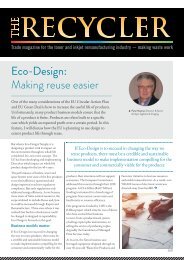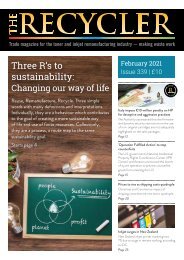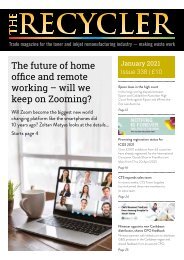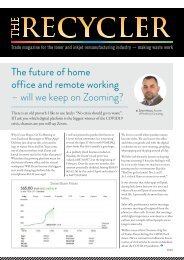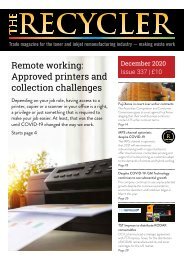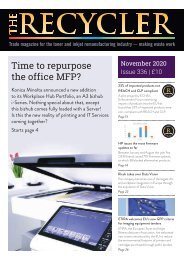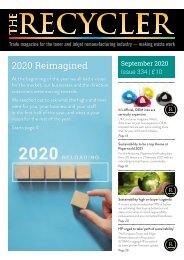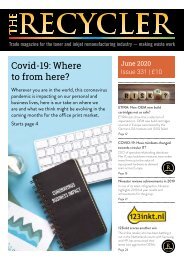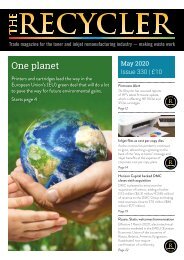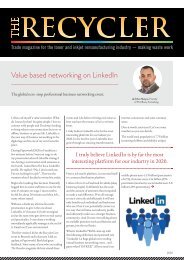The Recycler Issue 316
You also want an ePaper? Increase the reach of your titles
YUMPU automatically turns print PDFs into web optimized ePapers that Google loves.
WORLD FOCUS<br />
Search for <strong>The</strong> <strong>Recycler</strong> on Facebook for more news and industry coverage<br />
GLOBAL Xerox, Toner, Styrene<br />
Concerns raised over printer-related health problems<br />
This month, worries over the potential health hazards of printing have been making headlines, and Xerox has been<br />
weighing in on the issue.<br />
<strong>The</strong> aftermarket industry has already<br />
been troubled by the discovery of DecaBDE<br />
in some third-party cartridges, but now<br />
tests conducted by Xerox on Chinese<br />
manufactured toner have also revealed<br />
worrying levels of styrene.<br />
As the OEM explained, some people opt<br />
to buy third-party toner cartridges out of a<br />
desire to save money – but the cartridges<br />
they purchase could potentially pose a<br />
serious health risk.<br />
Xerox’s Analytical Services Department<br />
tested a widely available Chinesemanufactured<br />
aftermarket toner designed<br />
for use with the Xerox Phaser 6510 printer.<br />
“<strong>The</strong> results,” said Xerox, “shocked us.”<br />
<strong>The</strong> styrene levels contained in the<br />
aftermarket toner were at 650 parts per<br />
million (ppm) vs. 4 ppm in Xerox genuine<br />
toner, a difference of 16,510 percent.<br />
Xerox explained that its safety guideline<br />
for this substance is less than 25 ppm.<br />
<strong>The</strong> OEM went on to warn that “You<br />
might be putting your health, and the<br />
health of others, at risk by using bargainbrand<br />
toner cartridges” as they can<br />
“introduce higher amounts of styrene into<br />
the indoor office air you and your coworkers<br />
breathe each workday.”<br />
According to the Agency for Toxic<br />
Substances & Disease Registry, exposure to<br />
styrene “may harm you”, though to what<br />
degree will depend on the amount and the<br />
circumstances of exposure.<br />
Styrene, which “is widely used to make<br />
plastics and rubber”, has been found to<br />
affect the nervous systems of workers<br />
exposed to the chemical, causing “changes<br />
in colour vision, tiredness, feeling drunk,<br />
slowed reaction time, concentration<br />
problems, and balance problems.”<br />
In addition, the Department of Health<br />
and Human Services (DHHS) has listed the<br />
chemical as “reasonably anticipated to be a<br />
human carcinogen”, findings reiterated by<br />
California’s Office of Environmental Health<br />
Hazard Assessment, which has cited<br />
studies showing that styrene “increased the<br />
incidence of combined malignant and<br />
benign lung tumours.”<br />
Consequently, in April 2016, the State of<br />
California put styrene on its list of<br />
chemicals known to cause cancer.<br />
Xerox concluded its revelations about its<br />
styrene tests by explaining that “Through<br />
the oversight of the Xerox Environmental<br />
Health & Safety organisation, we’ve long<br />
worked toward minimising the use of<br />
hazardous substances in our products.”<br />
Significantly, the tests conducted by the<br />
OEM have not been the only studies to raise<br />
troubling questions over the potential<br />
dangers of printing.<br />
As CHEMISTRY WORLD reports, Philip<br />
Demokritou and a team of researchers has<br />
led a five-year study into the health<br />
implications of these nanomaterials,<br />
conducting in vitro and in vivo studies “to<br />
assess the specific toxicological effects of<br />
these nanoparticles in animals.” <strong>The</strong>ir<br />
findings reveal that these nanoparticles can<br />
become airborne, “enter the lungs and even<br />
reach the bloodstream.”<br />
<strong>The</strong>se nanoparticles are found in toners<br />
used in laser printers. During the printing<br />
process, the particles “can react with volatile<br />
organic compounds to form potentially<br />
carcinogenic compounds, which people can<br />
inhale and accumulate in their lungs.”<br />
Demokritou and his researchers utilised<br />
nuclear magnetic spectroscopy and gas<br />
chromatography mass spectrometry during<br />
their study. <strong>The</strong>y proved that “low<br />
molecular weight gaseous polycyclic<br />
aromatic hydrocarbons from toner powders<br />
interact with these catalytic nanoparticles<br />
and, under the high temperatures used<br />
during printing, form high molecular<br />
weight species.”<br />
<strong>The</strong>se high molecular species are<br />
potentially both carcinogenic and<br />
mutagenic.<br />
According to Demokritou, “assessing<br />
the nano-risk early on during product<br />
development while there is still a window to<br />
apply “safer-by-design” approaches can<br />
maximise the benefits of using nanoscale<br />
materials while minimising the potential<br />
health implications”.<br />
As a result of this study’s revelations,<br />
Demokritou has now become part of<br />
a partnership between Nanyang<br />
Technological University in Singapore and<br />
Harvard, aimed at examining the effects of<br />
long-term nanomaterial exposure in<br />
humans.<br />
ASIA HYB, New Partnership<br />
HYB and Daiken forge new partnership<br />
HYB has announced that, following “a fruitful discussion”, the company has entered a strategic partnership with<br />
DAIKEN CHEMICAL CO, LTD.<br />
As a result of this new alliance, HYB (full<br />
name, Zhuhai HaoYinBao Printing<br />
Consumables Co, Ltd) has become<br />
DAIKEN’s authorised toner distributor<br />
for the global market.<br />
DAIKEN has been in business since<br />
1951, specialising in “distinctive research<br />
to develop different kinds of chemicals”,<br />
as HYB explains, with its core business<br />
centred around the bulk production of<br />
colour toner for use in imaging devices.<br />
According to HYB, DAIKEN is “glad”<br />
to welcome HYB as its new distributor,<br />
which should help “drive the growth of<br />
the business for both parties.”<br />
Osamu Minokawa, Sales Manager at<br />
DAIKEN, along with the rest of the<br />
company’s management team, has “a<br />
high expectation” of this new<br />
partnership, which is described as<br />
“another piece of positive news for<br />
HYB.”<br />
Indeed, HYB has been no stranger to<br />
positive outcomes in recent months, as<br />
in 2018 the company was able to report<br />
various fruitful business developments,<br />
among them the naming of new<br />
distributors in Zimbabwe and Italy, as<br />
well as the unveiling of a new multifunctional<br />
hall in South America, and<br />
a Ministry certification awarded by<br />
China’s Ministry of Environmental<br />
Protection.<br />
12 THE RECYCLER • ISSUE <strong>316</strong> • MARCH 2019





